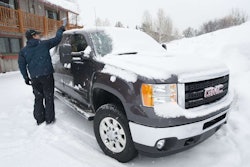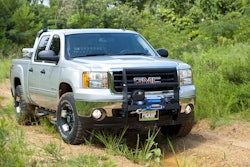Straps ‘N’ Tie-Downs
Some simple guidelines to keeping your cargo under control
There are a number of ways to secure cargo in the bed of your truck or on a trailer.
Doing so is straightforward stuff, but be advised—in a vehicle accident something as small and simple as a coffee mug can become a deadly missile.
Imagine what happens when those lawnmowers or that stack of drywall or that antique car break free and start tumbling down the road into traffic.
Ugly, yes. And often deadly and one hell of a hit on your insurance, not to mention the injuries you may suffer.
So here’s rule one: Everything has to be tied down. If you have to hit the brakes, make a sudden swerve, or drop off a road shoulder and everything stays put you’ve done your job.
There are a number of products that can help you with this. Here’s a look at what they can and can’t do.
Bungee cords
These are great for holding down flapping tarps, trimmers and rakes to trailer sides, and other lightweight applications.
But in most contractor cases, because they stretch, they’re not suitable for securing cargo. Use where appropriate, use the correct length, and check them every so often for frays or wear.
Cam straps
These are nylon web straps with a simple cam device to keep them tight. Thread the loose end through the opening in the cam and pull tight. You won’t find these much wider than 1 to 1 ½ inches because they won’t hold heavy loads.
But they’re usually good for small stacks of lumber, ladders, a few sheets of plywood and such.
Ratchet straps
Every contractor and landscaper should have a lot of these handy. Ratchet straps come in widths from 1 to 4 inches and use a ratcheting handle ratchet to tighten and secure the load. The wider products can spec out at 20,000 pounds break strength and a 5,000 pound work load limit.*
They come in longer lengths too, anywhere from 10 to 20 feet, with custom sizes available as well.
Ratchet straps can exert more down force on your load than cam straps because of the mechanical action of the ratcheting mechanism. They stay tight too, because of the metal gearing. (Cam straps can loosen over time or when it rains because of the gripper design .)
Some ratchet straps will have a D-ring or woven loop to secure the loose end—a nice feature if you’re going to be racking up long distance highway miles and don’t want a noisy nylon whip lashing your cargo or messing with your enjoyment of those Molly Hatchet tunes on your sound system.
Wheel nets
If you’re going to tow a piece of equipment ofr ATV on a trailer, the safest way is with wheel nets in addition to chains or ratchet straps.
 Miller by Mac's Pro Pack includes heavy duty items such as Mac’s Custom Tie-Down's axle straps, ratchet straps, and strap wraps to ensure that drivers are prepared for a variety of different equipment/vehicle transport situations.
Miller by Mac's Pro Pack includes heavy duty items such as Mac’s Custom Tie-Down's axle straps, ratchet straps, and strap wraps to ensure that drivers are prepared for a variety of different equipment/vehicle transport situations.
Wheel nets wrap half way around your tires and then tie into the anchor points on your trailer. These not only hold your vehicle more securely than straps and chains but they greatly reduce the chance of your damaging axles, brakes and suspension components.
ABOUT STRENGTH RATINGS
Nylon straps typically come with two strength ratings, a working load limit (WLL) and a breaking strength.
The WLL is typically 25 to 30 percent of the breaking limit and the only figure you should pay close attention to when making your purchase.
Why the difference? Because that 1,200-pound zero-turn mower, 1,600 pound Kawasaki Mule, or 3,500 pound pallet of rock you might be hauling to the job will for the briefest of moments triple its weight in G-force force should you have to slam on your brakes suddenly.
So use the WLL to calculate your strap needs and give yourself plenty of margin of error. Straps are cheap. Losing a load isn’t. — Tom Jackson
GOOD TIE-DOWN RESOURCES:
EK USA
www.ekusa.com
Towing and trailering basics
www.hagerty.com
U.S. Cargo Control
www.uscargocontrol.com
Mac’s Custom Tie Downs
www.macscustomtiedowns.com
Ratchet Straps USA
www.ratchetstraps.com








